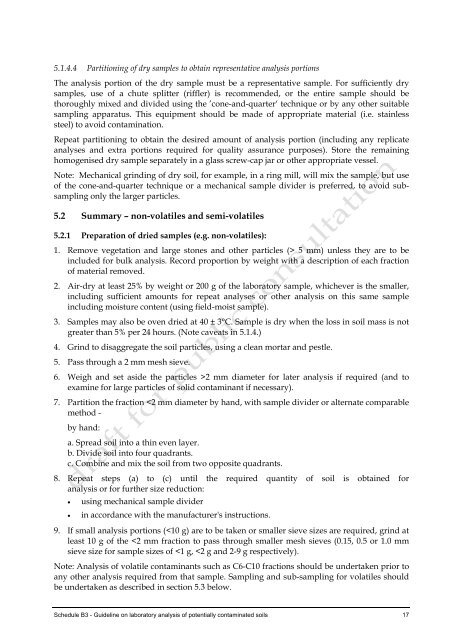Schedule B3 - COAG Standing Council on Environment and Water
Schedule B3 - COAG Standing Council on Environment and Water
Schedule B3 - COAG Standing Council on Environment and Water
- No tags were found...
You also want an ePaper? Increase the reach of your titles
YUMPU automatically turns print PDFs into web optimized ePapers that Google loves.
5.1.4.4 Partiti<strong>on</strong>ing of dry samples to obtain representative analysis porti<strong>on</strong>s<br />
The analysis porti<strong>on</strong> of the dry sample must be a representative sample. For sufficiently dry<br />
samples, use of a chute splitter (riffler) is recommended, or the entire sample should be<br />
thoroughly mixed <strong>and</strong> divided using the ’c<strong>on</strong>e-<strong>and</strong>-quarter‘ technique or by any other suitable<br />
sampling apparatus. This equipment should be made of appropriate material (i.e. stainless<br />
steel) to avoid c<strong>on</strong>taminati<strong>on</strong>.<br />
Repeat partiti<strong>on</strong>ing to obtain the desired amount of analysis porti<strong>on</strong> (including any replicate<br />
analyses <strong>and</strong> extra porti<strong>on</strong>s required for quality assurance purposes). Store the remaining<br />
homogenised dry sample separately in a glass screw-cap jar or other appropriate vessel.<br />
Note: Mechanical grinding of dry soil, for example, in a ring mill, will mix the sample, but use<br />
of the c<strong>on</strong>e-<strong>and</strong>-quarter technique or a mechanical sample divider is preferred, to avoid subsampling<br />
<strong>on</strong>ly the larger particles.<br />
5.2 Summary – n<strong>on</strong>-volatiles <strong>and</strong> semi-volatiles<br />
5.2.1 Preparati<strong>on</strong> of dried samples (e.g. n<strong>on</strong>-volatiles):<br />
1. Remove vegetati<strong>on</strong> <strong>and</strong> large st<strong>on</strong>es <strong>and</strong> other particles (> 5 mm) unless they are to be<br />
included for bulk analysis. Record proporti<strong>on</strong> by weight with a descripti<strong>on</strong> of each fracti<strong>on</strong><br />
of material removed.<br />
2. Air-dry at least 25% by weight or 200 g of the laboratory sample, whichever is the smaller,<br />
including sufficient amounts for repeat analyses or other analysis <strong>on</strong> this same sample<br />
including moisture c<strong>on</strong>tent (using field-moist sample).<br />
3. Samples may also be oven dried at 40 ± 3°C. Sample is dry when the loss in soil mass is not<br />
greater than 5% per 24 hours. (Note caveats in 5.1.4.)<br />
4. Grind to disaggregate the soil particles, using a clean mortar <strong>and</strong> pestle.<br />
5. Pass through a 2 mm mesh sieve.<br />
6. Weigh <strong>and</strong> set aside the particles >2 mm diameter for later analysis if required (<strong>and</strong> to<br />
examine for large particles of solid c<strong>on</strong>taminant if necessary).<br />
7. Partiti<strong>on</strong> the fracti<strong>on</strong>
















